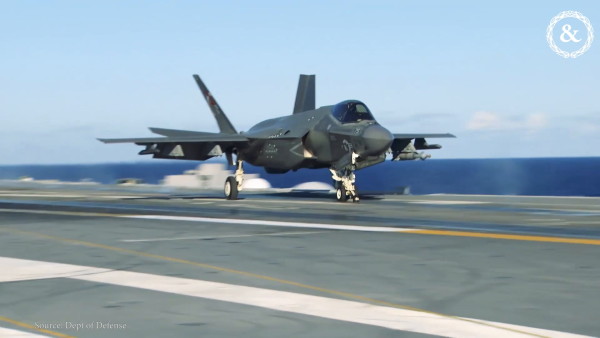

The U.S. military’s growing fleet of F-35 stealth fighters will fall short of the 80 percent readiness goal that former Defense Secretary James Mattis instituted before quitting in protest of President Donald Trump’s foreign policy in January 2019.
Former Secretary of the Army Mark Esper, who is Trump’s nominee to replace Mattis, in mid-July 2019 told a Senate committee the roughly 300-strong fleet of F-35s belonging to the U.S. Air Force, Navy and Marine Corps “is not expected” to meet Mattis’s readiness goal.
Esper blamed the F-35’s canopy, or “transparency.”
“Transparency supply shortages continue to be the main obstacle to achieving this,” Esper told the committee. “We are seeking additional sources to fix unserviceable canopies.”
The Government Accountability Office highlighted the canopy shortage in an April 2019 report. The F-35’s canopy, which features a special coating that reflects radar waves and prevents them from bouncing off the inside of the cockpit — a potentially major source of radar returns — “failed more frequently than expected,” the GAO pointed out.
Lockheed Martin, which builds the F-35, searched for an additional subcontractor to help boost canopy-production, the GAO reported.
The F-35 isn’t the only warplane to fall short of the readiness goal. Mattis directed all Air Force, Navy and Marine Corps F-15, F-16, F/A-18, F-22 and F-35 squadrons to achieve an 80 percent mission-capable rate by the end of September 2019.
U.S. Air Force Capt. Andrew “Dojo” Olson, F-35 Demonstration Team pilot and commander, performs a dedication pass during the Melbourne Air and Space Show in Melbourne, Fla., March 30, 2019
(U.S. Air Force/Senior Airman Alexander Cook)

The F-16 fleet is expected to meet the readiness goal this year, Esper told the Senate. The Navy and Marines have reported that the F/A-18 force also will meet the goal.
But the Air Force’s small fleet of F-22 stealth fighters, like the F-35 fleet, likely will fall short of Mattis’s benchmark, Air Force brigadier general Heath Collins, the service’s program executive officer for fighters and bombers, said in June 2019.
The failure wasn’t for a lack of trying. The Air Force in 2018 and 2019 shifted $750 million into maintenance accounts for the F-22 and F-16 fleets in the hope of meeting Mattis’s goal.
The flying branch also temporarily withdrew F-22s from the Middle East, ending five years of continuous F-22 operations in the region. Older F-15C fighters for several months took over for the F-22s.
The extra spending and a break from Middle East ops weren’t enough to boost the F-22’s mission-capable rate. Since becoming operational in 2005, the 187 F-22s have achieved roughly a 50-percent readiness rate, on average — one of the lowest rates of all U.S. fighter types.
The F-22’s complex systems and delicate, radar-absorbing coating require intensive maintenance. The F-35 is proving equally hard to keep in the air.
The stealth fighter’s readiness woes come as new performance problems with the type also have come to light. Defense News in June 2019 obtained military documents detailing a wide range of serious problems with two of the three versions of the F-35.
The Air Force’s F-35A appears to be exempt from the latest flaws, but the Marine Corps’ vertical-landing F-35B and the Navy’s carrier-compatible F-35C both suffer what the services call “category 1” deficiencies.
In military parlance, a category-1 flaw in a plane can prevent a pilot from accomplishing their mission.
One problem cropped up during test flights in 2011, Defense News reported, citing the trove of military documents. In the 2011 tests, at least one F-35B and F-35C both flew at speeds of Mach 1.3 and Mach 1.4. A post-flight inspection in November 2011 revealed the F-35B sustained “bubbling blistering” of its stealth coating.
Further supersonic tests in December 2011 revealed structural damage on an F-35C resulting from the extreme heat coming from the plane’s single Pratt & Whitney engine, one of the most powerful fighter engines ever made.
To avoid similar damage, the military has limited F-35B and F-35C pilots to flying at supersonic speed for less than a minute at a time.
The test reports Defense News obtained reveal a second, previously little-known category-1 deficiency in the F-35B and F-35C aircraft. If during a steep climb the fighters exceed a 20-degree “angle of attack” — the angle created by the wing and the oncoming air — they could become unstable and potentially uncontrollable.
This article originally appeared on The National Interest
More from The National Interest: